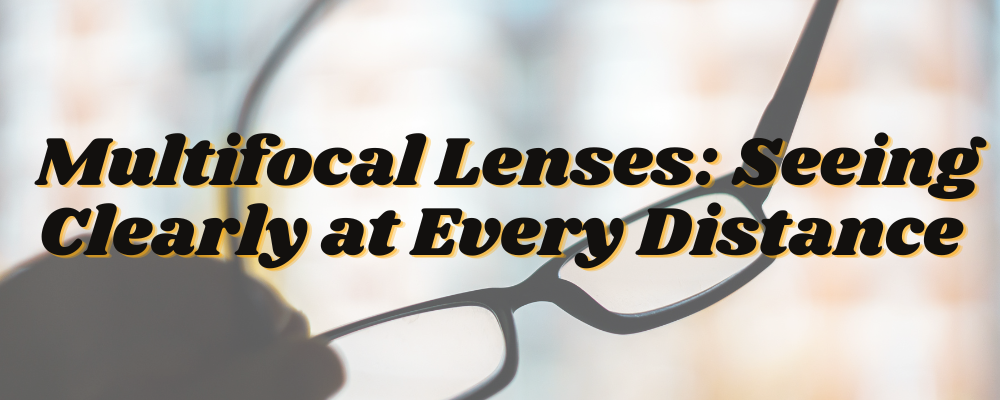
Clear vision is vital in our fast-paced world. Multifocal lenses offer a solution. In this guide, we explore their benefits, types, and impact on daily life. Discover the science behind these lenses and find the perfect pair for your lifestyle. From reading to scenic views, these lenses adapt, ensuring you never miss a detail. Join us as we delve into the world of multifocal lenses, enriching your experiences and empowering your vision.
Understanding Presbyopia
As the years pass, our bodies undergo various transformations, and our eyes are no exception. One common age-related vision change that affects nearly everyone over the age of 40 is presbyopia. This condition, stemming from the natural aging process, impacts our ability to focus on close-up objects, making activities like reading, using smartphones, or working on a computer screen increasingly challenging.
The Biological Shift: How Presbyopia Occurs
Presbyopia occurs due to changes in the eye’s lens and surrounding muscles. Our eye’s lens, responsible for adjusting its shape to focus on objects at different distances, becomes less flexible over time. This flexibility is vital for shifting focus between near and distant objects. As the lens loses its suppleness, it struggles to accommodate these changes, resulting in blurred vision when viewing close objects.
Recognizing the Signs: Symptoms of Presbyopia
The onset of presbyopia is gradual, and individuals might not notice significant changes until around the age of 40. Common signs include difficulty reading small print, holding reading materials at arm’s length, eye strain, headaches, and the need for brighter lighting when engaging in close-up tasks. If you notice these symptoms, it’s crucial to schedule an eye examination promptly.
Addressing Presbyopia: Exploring Multifocal Lenses
Presbyopia is a natural part of the aging process, but it doesn’t mean sacrificing a clear vision quality. Multifocal lenses stand as a reliable solution. Unlike traditional single-vision lenses, multifocal lenses feature multiple prescription powers within one lens. This ingenious design allows wearers to seamlessly shift their focus between near, intermediate, and distant objects without changing glasses.
Consultation and Customization: Tailoring Solutions for Individuals
When presbyopia becomes noticeable, consulting an eye care professional is essential. Optometrists or ophthalmologists conduct comprehensive eye exams to assess the extent of presbyopia and determine the right prescription for multifocal lenses. Factors such as lifestyle, occupation, and personal preferences are considered, ensuring a customized solution that fits seamlessly into an individual’s daily life.
Embracing Clarity: Living Comfortably with Presbyopia
Presbyopia, although a natural part of aging, doesn’t hinder a fulfilling life. With advancements in eyewear technology, individuals can maintain their active lifestyles and continue engaging in close-up activities with ease. Understanding presbyopia and its solutions empowers individuals to make informed decisions about their eye health, ensuring they embrace the world with clarity and confidence, regardless of age.
Types of Multifocal Lenses
With multifocal lenses, you may effortlessly switch between near, intermediate, and far-off objects, making them a flexible option for a wide range of vision requirements. Selecting the appropriate eyewear requires an understanding of the many varieties.
Bifocal Lenses
A visible line divides the two independent parts of a bifocal lens. The lower half deals with tasks that require close vision, while the upper part corrects distant vision. Users turn their heads to make use of the relevant area.
StickTite
- Stick-on bifocal lens instantly convert sunglasses, goggles, or glasses into magnified, bifocal sunglasses. Patented material technology, reusable lenses (1 pair) 2.5 diopter
Trifocal Lenses
An intermediate segment separates the close and distant parts of trifocal lenses. This middle zone provides clear eyesight at arm’s length for things like computer work.
SOPHILY
- he bottom part of the lens is full-power magnification, the normal power you choose for reading. The middle part is slightly reduced power magnification for working on computer, watching TV, etc. Top part is half-power magnification for daily communication. Progressive multi focus glasses are suitable for you who need to perform various activities throughout the day without switching glasses with different strengths
Progressive Lenses
Progressive lenses remove visible lines; they are frequently referred to as no-line bifocals. Rather, they have a prescribed strength gradient. Because of the seamless transition provided by this design, users may observe objects at different distances without experiencing sharp shifts.
SKYOAK
- Premium 2 PACK Durable Progressive Multifocus Reading Glasses for Men Blue Light Blocking Computer Reader Anti Eyestrain Metal Frame Spring Hinges (for Mid-Near Range approx 3ft) 2.5 Gunmetal
Monovision Lenses
Wearing contact lenses or spectacles with a prescription for near vision in one eye and for far vision in the other is known as monovision. The brain adjusts, using the right eye at various distances.
EYEKEPPER
- This reading glasses is designed to meet the needs of farsighted people who have different diopters in each eye. You can choose different lens power directly on your reader.
Multifocal Contact Lenses
The same multifocal design is available in a contact lens format with multifocal contact lenses. They are a great option for people who lead active lifestyles because users may see clearly without the need for eyeglasses.
Advantages of Multifocal Lenses
Multifocal lenses offer diverse benefits, revolutionizing how individuals perceive the world.
- Seamless Transition:
Multifocal lenses eliminate the need to switch between glasses. Seamless transitions between near, intermediate, and distant vision enhance the user experience. - Convenience in Activities:
Activities like reading, using smartphones, and driving become effortless. Users can seamlessly focus on objects at different distances without changing eyewear. - Clarity Everywhere:
From reading fine print to enjoying scenic views, multifocal lenses ensure clarity. Users can engage in close-up tasks and relish distant landscapes without straining their eyes. - Aesthetic Appeal:
Progressive lenses lack visible lines, offering a natural appearance. Users enjoy clear vision without the telltale signs of traditional bifocals or trifocals. - Freedom of Movement:
Multifocal contact lenses provide freedom from glasses, allowing wearers to move and engage in sports without hindrance. These lenses are ideal for active lifestyles. - Customized Solutions:
Eye care professionals tailor multifocal lenses based on individual needs. Customized prescriptions ensure optimal vision correction, enhancing overall eye comfort. - Age-Related Vision Correction:
Multifocal lenses address presbyopia, an age-related condition affecting near vision. Individuals over 40 find relief, enjoying clear sight for all activities. - Boosted Confidence:
Clear, uninterrupted vision boosts confidence. Multifocal lenses empower wearers, enabling them to participate in activities without vision-related limitations. - Reduced Eye Strain:
By providing clear vision at all distances, multifocal lenses reduce eye strain. Users experience less fatigue, making daily tasks more comfortable. - Simplified Eye Care:
Multifocal lenses consolidate vision correction needs. Instead of juggling multiple pairs of glasses, users rely on one pair for diverse activities, simplifying eye care routines.
In summary, multifocal lenses revolutionize vision correction. Their seamless transitions, aesthetic appeal, and tailored solutions make them a preferred choice, enhancing the quality of life for wearers of all ages.
Choosing the Right Multifocal Lenses
Selecting the perfect multifocal lens involves understanding individual needs and available options.
- Understanding Personal Vision Needs: Begin by identifying specific vision requirements, whether for reading, computer work, or driving. Clear understanding guides lens selection.
- Consultation with an Eye Care Professional: Seek guidance from an eye care professional. Optometrists or ophthalmologists, conduct comprehensive eye exams, determining the extent of presbyopia and the right prescription.
- Bifocals, Trifocals, or Progressives: Consider bifocal lenses for near and distant vision. Trifocals add intermediate vision correction. Progressives offer smooth transitions without visible lines.
- Monovision Option: Monovision, using different prescriptions in each eye, suits some individuals. One eye focuses on near tasks, the other on distant objects, accommodating varied vision needs.
- Multifocal Contacts: Multifocal contact lenses provide an alternative to glasses. These lenses offer the same benefits in a convenient format, suitable for active lifestyles.
- Frame Selection: Frame choice impacts lens size and vision zones. Larger frames accommodate multifocal designs, ensuring clear vision across multiple distances.
- Trial Period: Some wearers may need an adjustment period to adapt to multifocal lenses. Eye care professionals monitor this phase, making necessary modifications.
- Lifestyle Considerations: Consider lifestyle factors like hobbies and occupations. Discuss specific visual challenges with the eye care professional to customize the lens solution.
- Regular Follow-Ups: Schedule follow-up appointments to assess lens performance. Adjustments, if needed, ensure optimal vision correction and wearer comfort.
- Embracing Enhanced Vision: Choosing the right multifocal lens enhances daily experiences. Clear sight for all activities leads to increased confidence and a higher quality of life.
In summary, the process of selecting multifocal lenses involves a collaborative effort between the wearer and eye care professionals. Understanding personal needs, exploring options, and regular follow-ups ensure a seamless transition to enhanced vision.
Progressive Multifocal Glasses Buying Tips
When buying Progressive Multifocal Glasses, focus on clarity, durability, and comfort. Look for seamless transitions, anti-glare coatings, and scratch resistance. Read user reviews for reliable brands and accurate prescriptions. Elevate your vision effortlessly with our top picks!
Menicon Progent Biweekly Contact Lens Cleaner
- Progent Contact Lens Solution cleans lenses, loosens and removes surface protein deposits by simply soaking the lenses for 30 minutes.
- Treatment with Progent is recommended every 2 weeks. That means less hassle to maintain clean and comfortable lenses and clear eyes! The frequency may vary according to the condition of your lens. Follow your eye care professional’s directions
Final Thoughts on Multifocal Lenses and Their Role in Eye Care
Multifocal lenses have revolutionized eye care by offering versatile solutions for presbyopia and multifocal vision challenges. These lenses not only provide clear vision but also enhance the quality of life for wearers, enabling seamless transitions between tasks and distances.
Embracing multifocal lenses means embracing convenience, style, and precision in vision correction. With advancements in technology, these lenses have become more accessible, catering to diverse needs and preferences. It’s essential to consult with eye care professionals to find the right multifocal solution tailored to individual requirements.
In the realm of eye care, multifocal lenses stand as a testament to innovation and practicality, empowering wearers to navigate their daily activities with confidence and clarity. As eye care continues to evolve, multifocal lenses remain a key player, ensuring that people can experience the world with enhanced vision and comfort.








